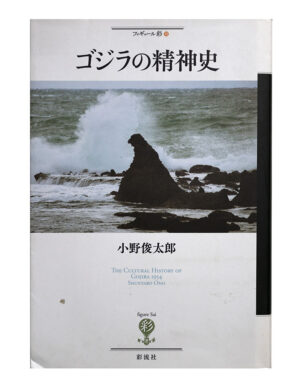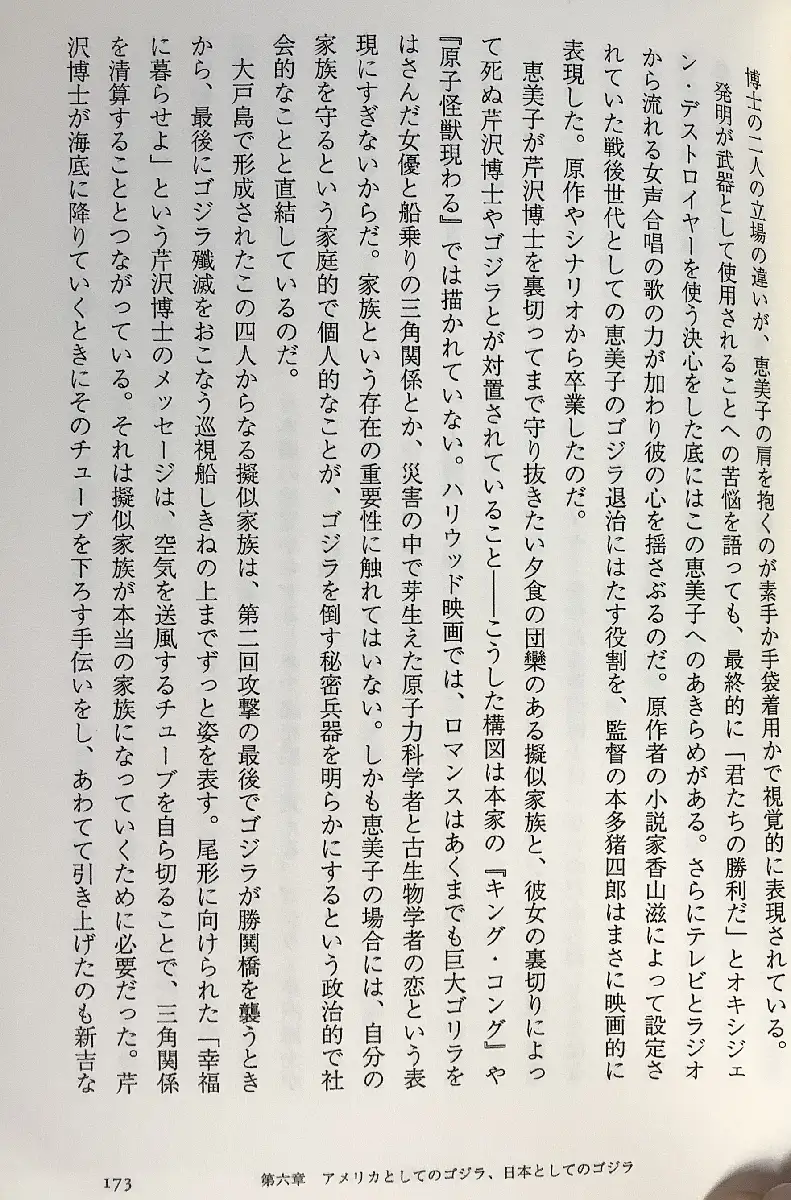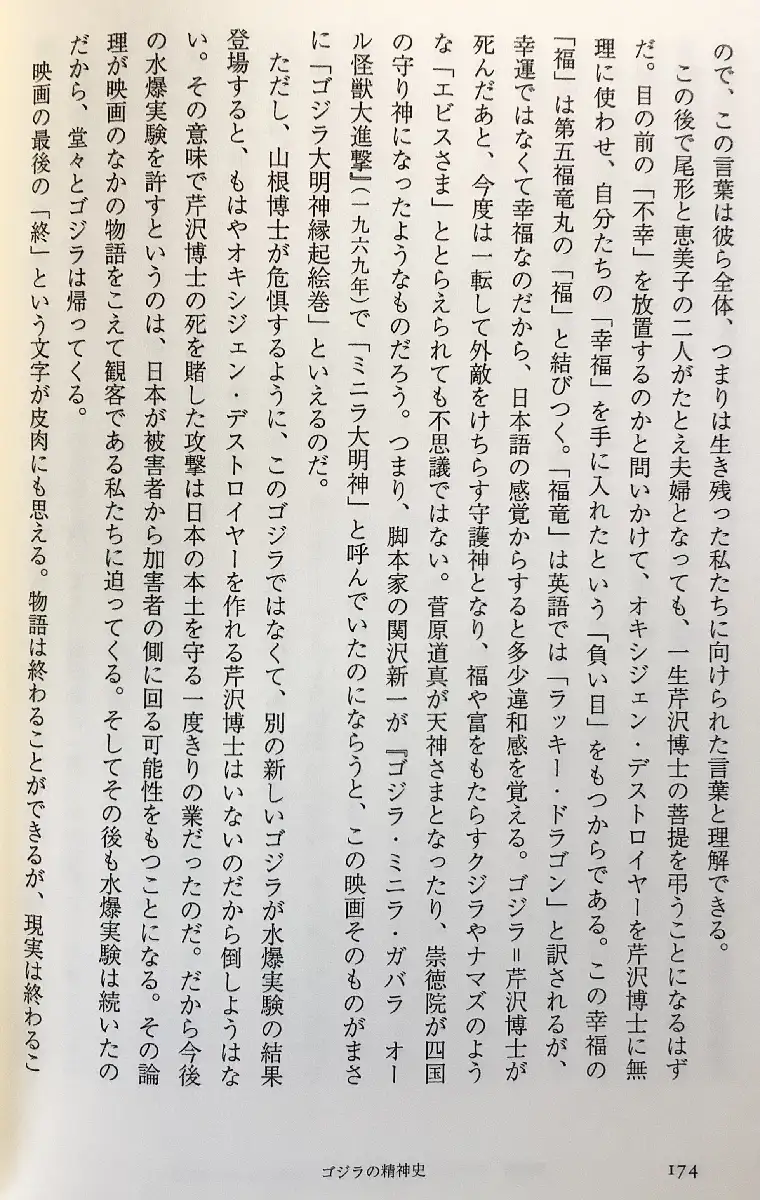8.27.2023
The Cultural History of Godzilla – Pt 64


P 173
発明が武器として使用されることへの苦悩を語っても、最終的に「君たちの勝利だ」とオキシジェン・デストロイヤーを使う決心をした底にはこの恵美子へのあきらめがある。さらにテレビとラジオから流れる女声合唱の歌の力が加わり彼の心を揺さぶるのだ。原作者の小説家香山滋によって設定されていた戦後世代としての恵美子のゴジラ退治にはたす役割を、監督の本多猪四郎はまさに映画的に表現した。原作やシナリオから卒業したのだ。
Even though he talks about his anguish about having his invention used as a weapon, in the end he decided to use the Oxygen Destroyer, saying, “You guys win.” In addition, the power of the female chorus singing from the TV and radio adds to his heart. The role of Emiko as a post-war generation in exterminating Godzilla, which was set by the novelist Shigeru Kayama, the original author, is filmically expressed by director Ishiro Honda. He graduated from the original and scenario.
恵美子が芹沢博士を裏切ってまで守り抜きたい夕食の団欒のある擬似家族と、彼女の裏切りによって死ぬ芹沢博士やゴジラとが対置されていること―こうした構図は本家の『キング・コング』や『原子怪獣現わる』では描かれていない。ハリウッド映画では、ロマンスはあくまでも巨大ゴリラをはさんだ女優と船乗りの三角関係とか、災害の中で芽生えた原子力科学者と古生物学者の恋という表現にすぎないからだ。家族という存在の重要性に触れてはいない。しかも恵美子の場合には、自分の家族を守るという家庭的で個人的なことが、ゴジラを倒す秘密兵器を明らかにするという政治的で社会的なことと直結しているのだ。
Emiko betrays Dr. Serizawa and wants to protect it. The confrontation between Dr. Serizawa and Godzilla who die due to her betrayal – such a composition is not drawn in the original “King Kong” and “The Beast from 20,000 Fathoms.” In Hollywood movies, romance is nothing more than a love triangle between an actress and a sailor with a giant gorilla in between, or a love between a nuclear scientist and a paleontologist that sprouts in the midst of a disaster. The importance of the existence of a family is not touched upon. And in Emiko’s case, the homely and personal thing of protecting her own family is directly linked to the political and social thing of uncovering the secret weapon to defeat Godzilla.
大戸島で形成されたこの四人からなる擬似家族は、第二回攻撃の最後でゴジラが勝鬨橋を襲うときから、最後にゴジラ殲滅をおこなう巡視船しきねの上までずっと姿を表す。尾形に向けられた「幸福に暮らせよ」という芹沢博士のメッセージは、空気を送風するチューブを自ら切ることで、三角関係を清算することとつながっている。それは擬似家族が本当の家族になっていくために必要だった。芹沢博士が海底に降りていくときにそのチューブを下ろす手伝いをし、あわてて引き上げたのも新吉なので、この言葉は彼ら全体、つまりは生き残った私たちに向けられた言葉と理解できる。
Formed on Odo Island, this pseudo-family of four appears all the way from the end of the second attack, when Godzilla attacks Kachidoki Bridge, all the way up to the patrol ship Shikine, which finally kills Godzilla. Dr. Serizawa’s message to Ogata, “Live happily ever after,” is linked to the settlement of the triangular relationship by cutting the tube that blows the air. It was necessary for the pseudo-family to become a real family. Shinkichi was also the one who helped Dr. Serizawa lower the tube as he descended to the ocean floor and pulled it up in a hurry, so I can understand that this word was directed at all of them, in other words, at us who survived.

P 174
この後で尾形と恵美子の二人がたとえ夫婦となっても、一生芹沢博士の菩提を弔うことになるはずだ。目の前の「不幸」を放置するのかと問いかけて、オキシジェン・デストロイヤーを芹沢博士に無理に使わせ、自分たちの「幸福」を手に入れたという「負い目」をもつからである。この幸福の「福」は第五福竜丸の「福」と結びつく。「福竜」は英語では「ラッキー・ドラゴン」と訳されるが、幸運ではなくて幸福なのだから、日本語の感覚からすると多少違和感を覚える。ゴジラ=芹沢博士が死んだあと、今度は一転して外敵をけちらす守護神となり、福や富をもたらすクジラやナマズのよう「エビスさま」ととらえられても不思議ではない。菅原道真が天神さまとなったり、崇徳院が四国の守り神になったようなものだろう。つまり、脚本家の関沢新一が『ゴジラ・ミニラ・ガバラオール怪獣大進撃』(一九六九年)で「ミニラ大明神」と呼んでいたのにならうと、この映画そのものがまさに「ゴジラ大明神縁起絵巻」といえるのだ。
Even if Ogata and Emiko become husband and wife after this, they will surely mourn Dr. Serizawa’s death for the rest of their lives. This is because they have a “debt” that they have obtained their own “happiness” by forcing Dr. Serizawa to use the Oxygen Destroyer, asking if they will ignore the “misfortune” in front of them. The “fuku” of this happiness is connected to the “fuku” of the Daigo Fukuryu Maru. “Fukuryu” is translated as “lucky dragon” in English, but since it means happiness, not luck, it feels a little strange from the Japanese sense. After the death of Godzilla (Dr. Serizawa), it would not be surprising if Godzilla turned around and became a guardian deity who scorns foreign enemies, and is regarded as “Ebisu-sama” like a whale or catfish that brings good fortune and wealth. It would be like Sugawara no Michizane becoming Tenjin, or Sutokuin becoming the guardian deity of Shikoku. In other words, screenwriter Shinichi Sekizawa in “Godzilla, Minya, Gabaraor Monster Attack” (1969)
He called it “Minya Daimyojin [Deity with extraordinary spiritual powers]”, so this movie itself can be said to be “Godzilla Daimyojin Engi Emaki” [“Omen God Godzilla Picture].
Sugawara no Michizane, also known as Kan Shōjō (菅 丞相), a grandson of Sugawara no Kiyotomo (770–842) (known as Owari no suke and Daigaku-no kami), was a scholar, poet, and politician of the Heian Period of Japan. He is regarded as an excellent poet, particularly in Chinese poetry. (Source: Jisho.org)
ただし、山根博士が危惧するように、このゴジラではなくて、別の新しいゴジラが水爆実験の結果登場すると、もはやオキシジェン・デストロイヤーを作れる芹沢博士はいないのだから倒しようはない。その意味で芹沢博士の死を賭した攻撃は日本の本土を守る一度きりの業だったのだ。だから今後の水爆実験を許すというのは、日本が被害者から加害者の側に回る可能性をもつことになる。その論理が映画のなかの物語をこえて観客である私たちに迫ってくる。そしてその後も水爆実験は続いたのだから、堂々とゴジラは帰ってくる。
However, as Dr. Yamane fears, if instead of this Godzilla, another new Godzilla appears as a result of hydrogen bomb testing, Dr. Serizawa will no longer be able to create the Oxygen Destroyer, so there is no way to defeat him. In that sense, Dr. Serizawa’s death-defying attack was a one-time effort to protect the mainland of Japan. Therefore, permitting future hydrogen bomb tests means that Japan may turn from being a victim to being a perpetrator. That logic goes beyond the story in the film and approaches us, the audience. And since the hydrogen bomb test continued after that, Godzilla will return proudly.
映画の最後の「終」という文字が皮肉にも思える。物語は終わることができるが、現実は終わることができない、という当たり前の事実を六十年たっても教えてくれるからだ。
The word “end” at the end of the movie seems ironic. Even after 60 years, it teaches us the obvious fact that stories can end, but reality can’t.

P 175
そしてゴジラと芹沢博士の死を忘却することが生き残った人たちにとって罪となるように、日米和親条約で開国した後の近代の日本が他国に対しておこなったこと、またその日本に対して他国がおこなったことの両方を忘れないために、何度も思い起こす必要がある。その意味で初代の『ゴジラ』は日本人にとって今もするどい問いかけをもつ映画である。そして、すべての過去を「忘れるな」という強いメッセージをもつてゴジラはその後何度も蘇ってきたのだ。
And so that forgetting the deaths of Godzilla and Dr. Serizawa would be a crime for those who survived, what modern Japan did to other countries after the opening of the country with the Japan-U.S. Treaty of Peace and Amity, and also to Japan. It is necessary to remind ourselves again and again so that we do not forget what both countries have done. In that sense, the original “Godzilla” is a movie that still poses sharp questions to Japanese people. And Godzilla has been revived many times since then with a strong message of “don’t forget” all the past.